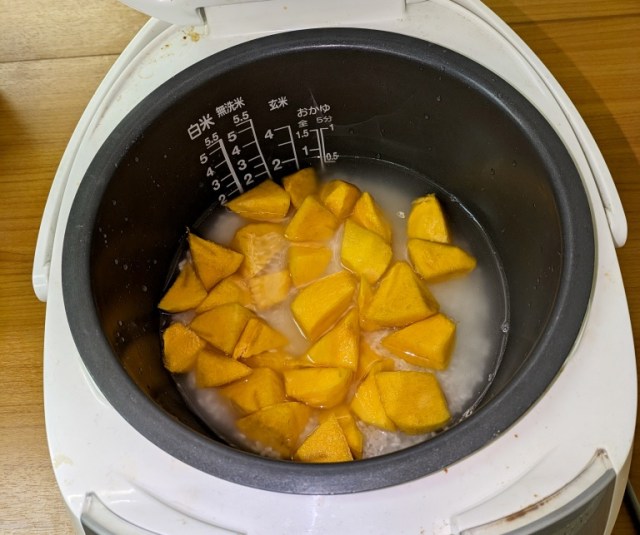
Persimmon rice takes just three steps to make.
Rice cookers are amazingly convenient appliances, letting you cook up a pot of perfectly fluffy white rice with mere seconds of prep work before you hit the start button and let the machine do the rest. But as we head deeper in autumn, it’s time to remember that you can also toss other ingredients into your rice cooker to make some super-easy, super-tasty dishes, and today we’ll be making kaki gohan, or “persimmon rice.”
Actually, we weren’t entirely sure that kaki gohan was a thing. With fall foods coming into season, at this time of year a lot of takeout places will soon be offering kuri gohan, rice cooked with chestnut pieces, but we couldn’t recall seeing kaki gohan for sale. In theory, though, it seemed like persimmon rice should be possible, and sure enough, we were able to track down a recipe from rice brand Yamato Rice on their website. With a short ingredient list and just three steps to follow, we wasted no time whipping up a batch.
● Ingredients
Rice (360 milliliters/1.5 cups)
1 persimmon
Water (270 milliliters/9.1 ounces)
Cooking sake (1 tablespoon)
Salt (0.5 teaspoons)
Black sesame and extra salt (to taste)
Step 1
Peel the persimmon, remove the seeds, and chop it into bite-size pieces.
Step 2
Put the persimmon, rice, water, sake, and salt into the rice cooker.
Step 3
Close the lid, hit the start button, and let the rice cooker go through its standard cooking cycle.
Yep, that’s really all there is to it! Our rice cooker’s cycle is 45 minutes long, so once it was done we popped open the lid…
…and our kaki gohan had cooked up quite nicely.
A tantalizing sweet aroma wafted up from the pot. Grabbing a rice scoop, we transferred a serving into a bowl, then added a dash of black sesame and a little extra salt.
We picked up a mouthful with our chopsticks, popped it into our mouth, and were met with a gentle, delicious sweetness. During cooking the juices excreted by the persimmon pieces had soaked into the rice, and the salt and sesame helped draw out more of that natural sweetnes through their contrasting flavor notes. Kaki gohan smells great too, with the slight scent of sake mixing harmoniously with the persimmon to give it just the right amount of olfactory character to stimulate your appetite without overpowering your nose.
One thing to keep in mind, though, is that the texture of cooked persimmon is ignorantly softer than when it’s raw. If you, like us, have eaten a whole lot more raw persimmon than cooked, the consistency might throw you off a bit at first. For something that tastes this good, though, and that’s so easy to make, it’s a texture we can get used to.
Related: Yamato Rice
Photos © SoraNews24
● Want to hear about SoraNews24’s latest articles as soon as they’re published? Follow us on Facebook and Twitter!
[ Read in Japanese ]

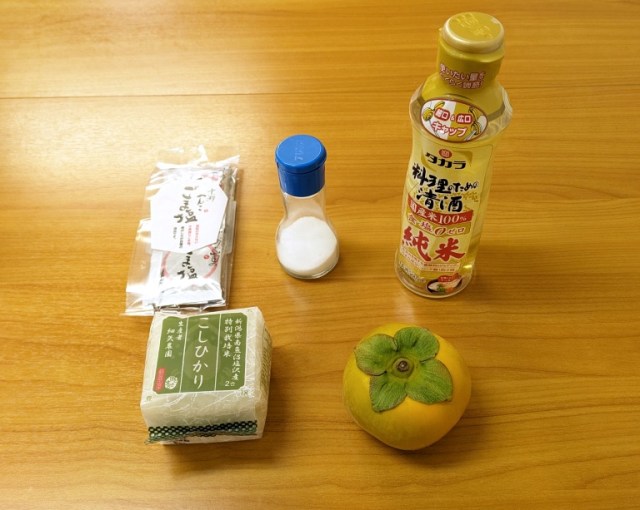
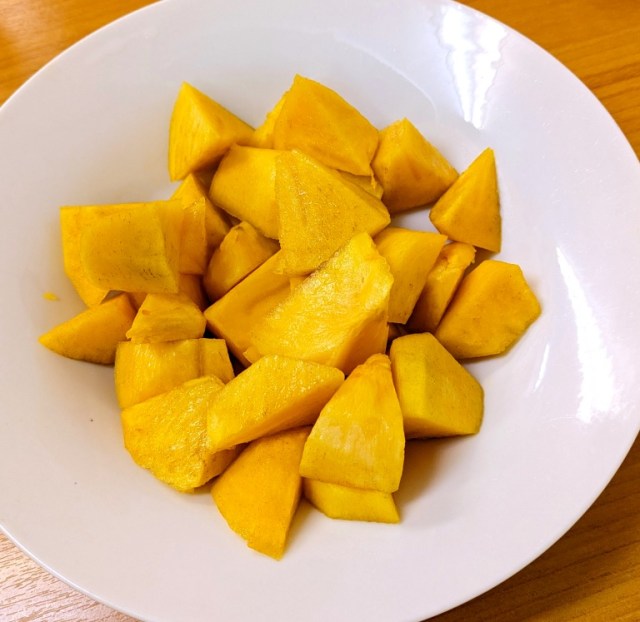
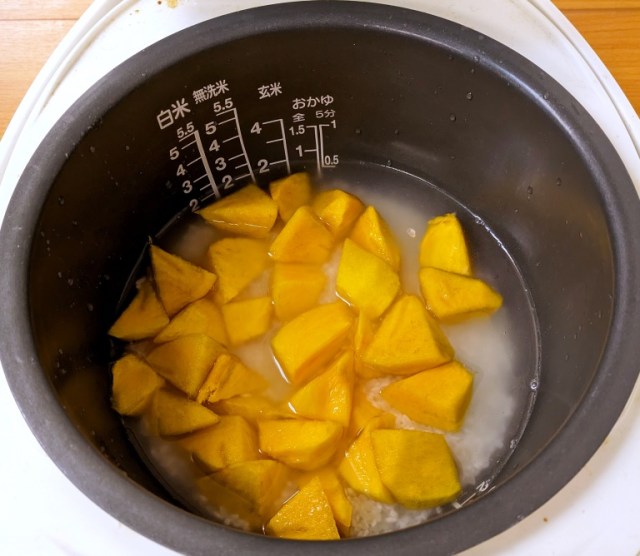
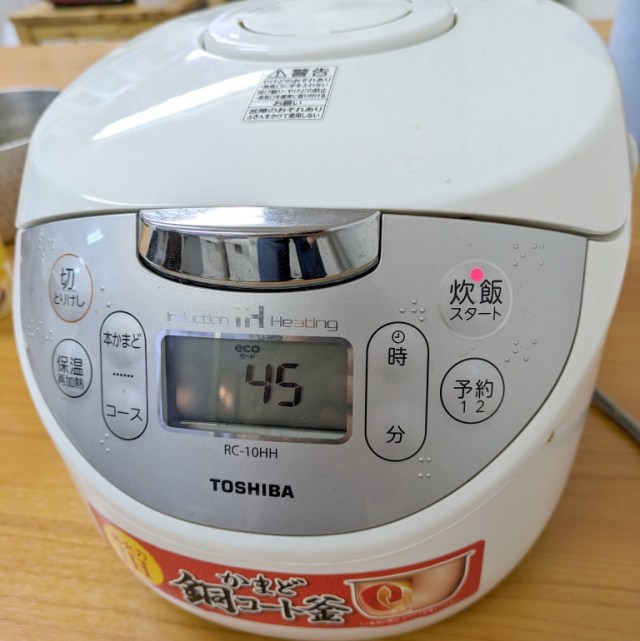
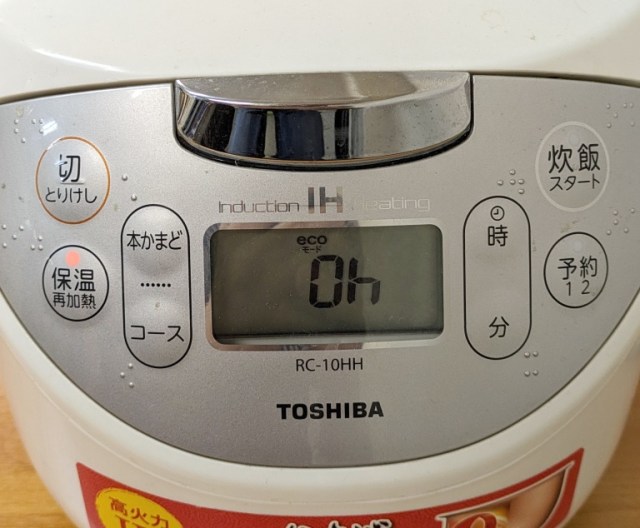
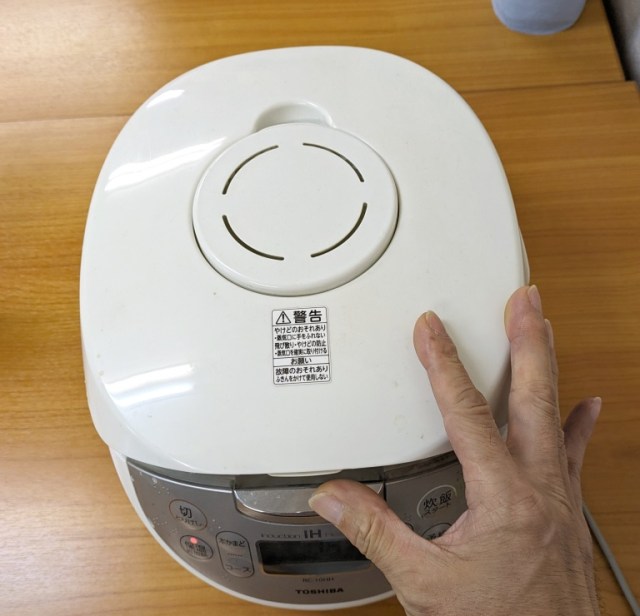
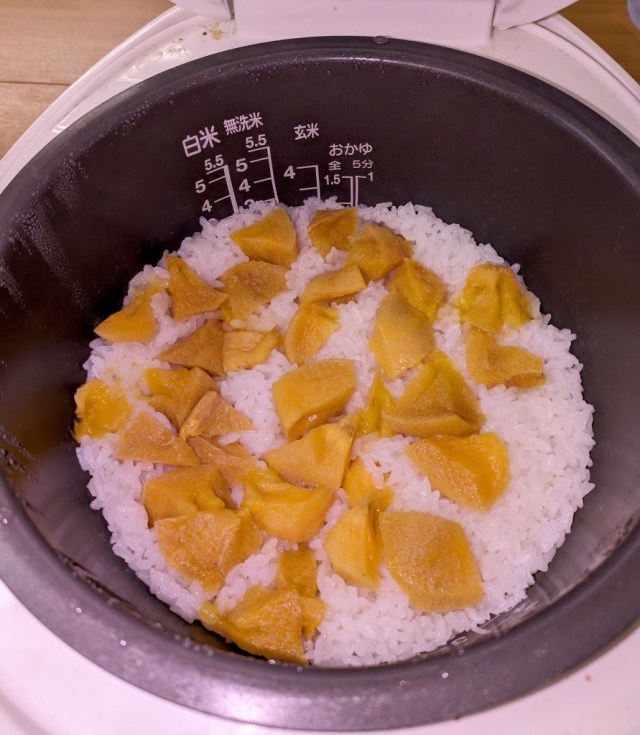
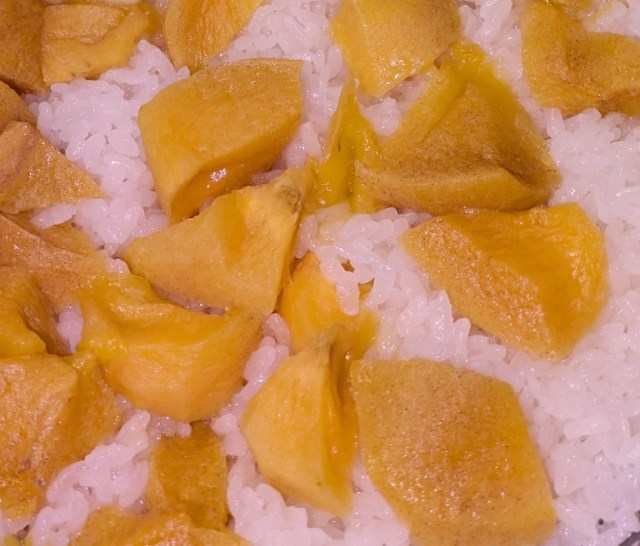
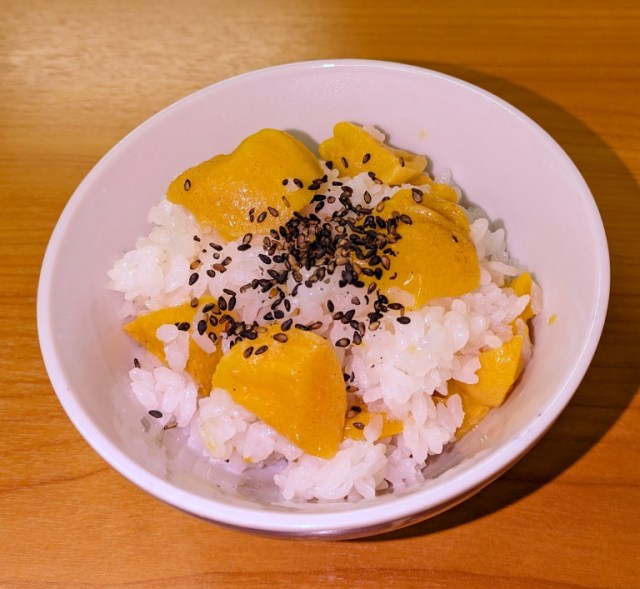
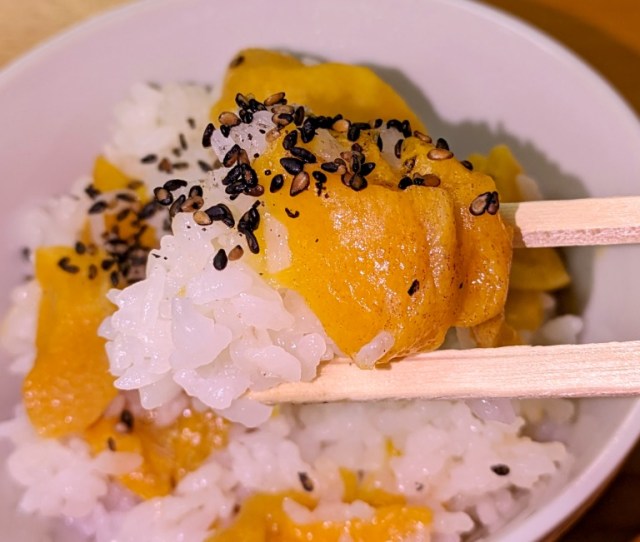
 Rice cooker kuri gohan and two more super-easy chestnut recipes to make this fall【SoraKitchen】
Rice cooker kuri gohan and two more super-easy chestnut recipes to make this fall【SoraKitchen】 Make matcha ice cream rice in your rice cooker with this easy recipe from Meiji
Make matcha ice cream rice in your rice cooker with this easy recipe from Meiji Super easy rice cooker recipe: KFC rice!
Super easy rice cooker recipe: KFC rice! Rice cooker recipe: 7-Eleven Japan’s Miso Mackerel Butter Rice is as tasty as it is easy
Rice cooker recipe: 7-Eleven Japan’s Miso Mackerel Butter Rice is as tasty as it is easy Can you make KFC takikomi gohan in a rice cooker, and is it something worth eating?【SoraKitchen】
Can you make KFC takikomi gohan in a rice cooker, and is it something worth eating?【SoraKitchen】 Majority of Japanese mayors say foreign residents are essential but most see good and bad effects
Majority of Japanese mayors say foreign residents are essential but most see good and bad effects Japanese beef bowl chain Sukiya’s 2026 Smile Box lucky bag basically pays for itself
Japanese beef bowl chain Sukiya’s 2026 Smile Box lucky bag basically pays for itself Should you dip your cake in sake? One Japanese brewer says no, but actually yes【 Taste test】
Should you dip your cake in sake? One Japanese brewer says no, but actually yes【 Taste test】 Village Vanguard’s most expensive Black Lucky Bag sets an ominous tone for 2026
Village Vanguard’s most expensive Black Lucky Bag sets an ominous tone for 2026 Disney’s Japanese New Year’s plushies and figures are ready to make oshogatsu cuter than ever
Disney’s Japanese New Year’s plushies and figures are ready to make oshogatsu cuter than ever “Demon manju”: A low-prep recipe for a delicious regional snack made from sweet potato
“Demon manju”: A low-prep recipe for a delicious regional snack made from sweet potato Ramen restaurant in Tokyo offers discount to customers who order ramen with no noodles
Ramen restaurant in Tokyo offers discount to customers who order ramen with no noodles 7-Eleven opens “next generation” SIP convenience store in Japan
7-Eleven opens “next generation” SIP convenience store in Japan We try the sweets, soups, pastas, and fried chicken of KFC’s all-you-can-eat buffet restaurant
We try the sweets, soups, pastas, and fried chicken of KFC’s all-you-can-eat buffet restaurant Sea urchin ramen – Not for the faint of heart!
Sea urchin ramen – Not for the faint of heart! Starbucks Japan ready to get Year of the Horse started with adorable drinkware and plushies【Pics】
Starbucks Japan ready to get Year of the Horse started with adorable drinkware and plushies【Pics】 Hayao Miyazaki says Happy New Year to Studio Ghibli fans with new art for Year of the Horse
Hayao Miyazaki says Happy New Year to Studio Ghibli fans with new art for Year of the Horse 7 great places to see Mt. Fuji from without having to climb it
7 great places to see Mt. Fuji from without having to climb it We found possibly the quietest Japanese-style hotel in Tokyo’s bustling Shinjuku district
We found possibly the quietest Japanese-style hotel in Tokyo’s bustling Shinjuku district Cup Noodle tries an authentic Jiro-style ramen, but something’s not quite right
Cup Noodle tries an authentic Jiro-style ramen, but something’s not quite right Hello Kitty Choco Egg figures are an adorable trip through three periods of Japanese pop culture【Pics】
Hello Kitty Choco Egg figures are an adorable trip through three periods of Japanese pop culture【Pics】 Japan’s oldest largetooth sawfish in captivity back on display in Mie Prefecture
Japan’s oldest largetooth sawfish in captivity back on display in Mie Prefecture Cyberpunk anime meets traditional culture in Ghost in the Shell gold leaf Japanese changing screens
Cyberpunk anime meets traditional culture in Ghost in the Shell gold leaf Japanese changing screens The best Starbucks Japan Frappuccinos we want to drink again in 2026
The best Starbucks Japan Frappuccinos we want to drink again in 2026 We revisited Sweets Paradise after a decade to see if Japan’s dessert buffet still delivers
We revisited Sweets Paradise after a decade to see if Japan’s dessert buffet still delivers 7-Eleven Japan starts new temporary luggage storage service in over 300 branches
7-Eleven Japan starts new temporary luggage storage service in over 300 branches Disillusionment at Tsukiji’s tourist-target prices led us to a great ramen restaurant in Tokyo
Disillusionment at Tsukiji’s tourist-target prices led us to a great ramen restaurant in Tokyo Starbucks teams up with 166-year-old Kyoto doll maker for Year of the Horse decorations【Photos】
Starbucks teams up with 166-year-old Kyoto doll maker for Year of the Horse decorations【Photos】 Tokyo considering law requiring more trash cans following litter increase in heavily touristed area
Tokyo considering law requiring more trash cans following litter increase in heavily touristed area Tokyo’s Tsukiji sushi neighborhood asks tour groups to stay away for the rest of the month
Tokyo’s Tsukiji sushi neighborhood asks tour groups to stay away for the rest of the month Tokyo event lets you travel back in time, for free, to celebrate 100 years since Showa era start
Tokyo event lets you travel back in time, for free, to celebrate 100 years since Showa era start Sanrio theme park in Japan announces plans to expand into a Sanrio resort
Sanrio theme park in Japan announces plans to expand into a Sanrio resort Japan may add Japanese language proficiency, lifestyle classes to permanent foreign resident requirements
Japan may add Japanese language proficiency, lifestyle classes to permanent foreign resident requirements Stamina-destroying “Paralysis Noodles” are Tokyo’s newest over-the-top ramen innovation
Stamina-destroying “Paralysis Noodles” are Tokyo’s newest over-the-top ramen innovation Survey asks foreign tourists what bothered them in Japan, more than half gave same answer
Survey asks foreign tourists what bothered them in Japan, more than half gave same answer Japan’s human washing machines will go on sale to general public, demos to be held in Tokyo
Japan’s human washing machines will go on sale to general public, demos to be held in Tokyo Japan’s deadliest food claims more victims, but why do people keep eating it for New Year’s?
Japan’s deadliest food claims more victims, but why do people keep eating it for New Year’s? We deeply regret going into this tunnel on our walk in the mountains of Japan
We deeply regret going into this tunnel on our walk in the mountains of Japan Studio Ghibli releases Kodama forest spirits from Princess Mononoke to light up your home
Studio Ghibli releases Kodama forest spirits from Princess Mononoke to light up your home Major Japanese hotel chain says reservations via overseas booking sites may not be valid
Major Japanese hotel chain says reservations via overseas booking sites may not be valid Put sesame oil in your coffee? Japanese maker says it’s the best way to start your day【Taste test】
Put sesame oil in your coffee? Japanese maker says it’s the best way to start your day【Taste test】 No more using real katana for tourism activities, Japan’s National Police Agency says
No more using real katana for tourism activities, Japan’s National Police Agency says Starbucks Japan reveals new sakura drinkware collection, inspired by evening cherry blossoms
Starbucks Japan reveals new sakura drinkware collection, inspired by evening cherry blossoms Updated cherry blossom forecast shows extra-long sakura season for Japan this year
Updated cherry blossom forecast shows extra-long sakura season for Japan this year We follow Twitter recipe to cook “coffee rice”! 【RocketKitchen】
We follow Twitter recipe to cook “coffee rice”! 【RocketKitchen】 Rice cooker recipe: How to make a giant cheesy okonomiyaki pancake in a rice cooker
Rice cooker recipe: How to make a giant cheesy okonomiyaki pancake in a rice cooker How to make a massive deep dish Chicago Pizza…in your rice cooker
How to make a massive deep dish Chicago Pizza…in your rice cooker Potato Chip Rice may be our easiest rice cooker recipe yet!
Potato Chip Rice may be our easiest rice cooker recipe yet! Nametake tuna rice: A delicious rice cooker recipe using just three ingredients【SoraKitchen】
Nametake tuna rice: A delicious rice cooker recipe using just three ingredients【SoraKitchen】 Did you know your rice cooker is also a ramen rice cooker?【SoraKitchen】
Did you know your rice cooker is also a ramen rice cooker?【SoraKitchen】 Chicken McNugget rice cooker rice — Can it beat KFC rice cooker rice?【SoraKitchen】
Chicken McNugget rice cooker rice — Can it beat KFC rice cooker rice?【SoraKitchen】 KFC Japan releases official onigiri rice ball, miso ramen rice recipes to level-up fried chicken
KFC Japan releases official onigiri rice ball, miso ramen rice recipes to level-up fried chicken Our recipe for green tea rice-cooker pancakes: amazingly tasty, ridiculously easy
Our recipe for green tea rice-cooker pancakes: amazingly tasty, ridiculously easy Ultimate lazy sukiyaki – Can you make the king of Japanese hot pots in a rice cooker?【Taste test】
Ultimate lazy sukiyaki – Can you make the king of Japanese hot pots in a rice cooker?【Taste test】 Rice cooker cooking: Bacon onion rice is amazingly easy, awesomely delicious
Rice cooker cooking: Bacon onion rice is amazingly easy, awesomely delicious Minimal effort, loads of flavor: Make juicy roast beef in your rice cooker with vacuum cooking!
Minimal effort, loads of flavor: Make juicy roast beef in your rice cooker with vacuum cooking! This buttery, garlicky sausage and rice recipe is simple, cheap, and pretty much to die for
This buttery, garlicky sausage and rice recipe is simple, cheap, and pretty much to die for This is what happens when you cook rice with coffee in your rice cooker 【Rocket Kitchen】
This is what happens when you cook rice with coffee in your rice cooker 【Rocket Kitchen】 Coffee-infused rice for rice balls and curry? Taste-testing a recipe from Japan’s coffee experts
Coffee-infused rice for rice balls and curry? Taste-testing a recipe from Japan’s coffee experts
Leave a Reply